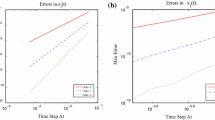Abstract
In the last decade it has become standard for students and researchers to be introduced to state-of-the-art numerical software through a problem solving environment (PSE) rather than through the use of scientific libraries callable from a high level language such as Fortran or C. In this paper we will identify the constraints and implications that this imposes on the ODE software we investigate and develop. In particular, the way a ‘numerical solution’ is displayed and viewed by a user dictates that new measures of performance and quality must be adopted. We will use the MATLAB environment and ODE software for initial value problems, boundary value problems and delay problems to illustrate the issues that arise and the progress that has been made. One of the major implications is the expectation that accurate approximations at ‘off-mesh’ points must be provided. Traditional numerical methods for ODEs have produced approximations to the underlying solution on an associated discrete, adaptively chosen mesh. In recent years it has become common for the ODE software to also deliver approximations at off-mesh values of the independent variable. Such a feature can be extremely valuable in applications and leads to new measures of quality and performance which are more meaningful to users and more consistently interpreted and implemented in contemporary ODE software. Numerical examples of the robust and reliable behaviour of such software will be presented and the cost/reliability trade-offs that arise will be quantified.
Similar content being viewed by others
References
U. Ascher, J. Christiansen and R. Russell, Collocation software for boundary value ODEs, ACM Trans. Math. Soft. 7(2) (1981) 209–222.
G. Bader and U. Ascher, A new basis implementation for a mixed order boundary value ODE solver, SIAM J. Sci. Comput. 8 (1987) 483–500.
R.F. Boisvert and P.T.P. Tang, eds., The Architecture of Scientific Software, IFIP International Federation for Information Processing, Vol. 188 (Kluwer, Boston, 2001).
W.H. Enright, The relative efficiency of alternative defect control schemes for high order Runge-Kutta formulas, SIAM J. Numer. Anal. 30(5) (1993) 1419–1445.
W.H. Enright, Accurate approximate solution of PDEs at off-mesh points, ACM Trans. Math. Soft. 26(2) (2000) 274–292.
W.H. Enright, Hierarchichal representation and computation of approximate solutions in scientific simulations, in: The Architecture of Scientific Software, eds. R.F. Boisvert and P.T.P. Tang (Kluwer, Boston, 2001) pp. 301–317.
W.H. Enright, Continuous numerical methods for ODEs with defect control, J. Comput. Appl. Math. 125 (2001) 159–170.
W.H. Enright and H. Hayashi, A delay differential equation solver based on a continuous Runge-Kutta method with defect control, Numer. Algorithms 16 (1997) 349–364.
W.H. Enright, K.R. Jackson, S.P. N¸rsett and P.G. Thomsen, Effective solution of discontinuous IVPs using a Runge-Kutta formula pair with interpolants, Appl. Math. Comput. 27 (1988) 313–335.
W.H. Enright and P.H. Muir, A Runge-Kutta type boundary value ODE solver with defect control, SIAM J. Sci. Comput. 17 (1996) 479–497.
W.H. Enright and P.H. Muir, Superconvergent interpolants for the collocation solution of BVODEs, SIAM J. Sci. Comput. 21 (1999) 227–254.
W.H. Enright and R. Sivasothinathan, Superconvergent interpolants for collocation methods applied to mixed order BVODEs, ACM Trans. Math. Soft. 26(3) (2000) 323–351.
H. Jin and S. Pruess, Uniformally superconvergent approximations for linear two-point boundary value problems, SIAM J. Numer. Anal. 35(1) (1998) 363–375.
J. Kierzenka and L.F. Shampine, A BVP solver based on residual control and the MATLAB PSE, Report 99-1, Math. Department, Southern Methodist University (1999).
L.F. Shampine and R.M. Corless, Initial value problems for ODEs in problem solving environments, J. Comput. Appl. Math. 125 (2001) 31–40.
L.F. Shampine and M.W. Reichelt, The MATLAB ODE suite, SIAM J. Sci. Comput. 18 (1997) 1–22.
L.F. Shampine and S. Thompson, Event location for ordinary differential equations, Comput. Math. Appl. 39 (2000) 43–54.
L.F. Shampine and S. Thompson, Solving DDEs in MATLAB, Manuscript.
Author information
Authors and Affiliations
Rights and permissions
About this article
Cite this article
Enright, W. The Design and Implementation of Usable ODE Software. Numerical Algorithms 31, 125–137 (2002). https://doi.org/10.1023/A:1021181115166
Issue Date:
DOI: https://doi.org/10.1023/A:1021181115166




